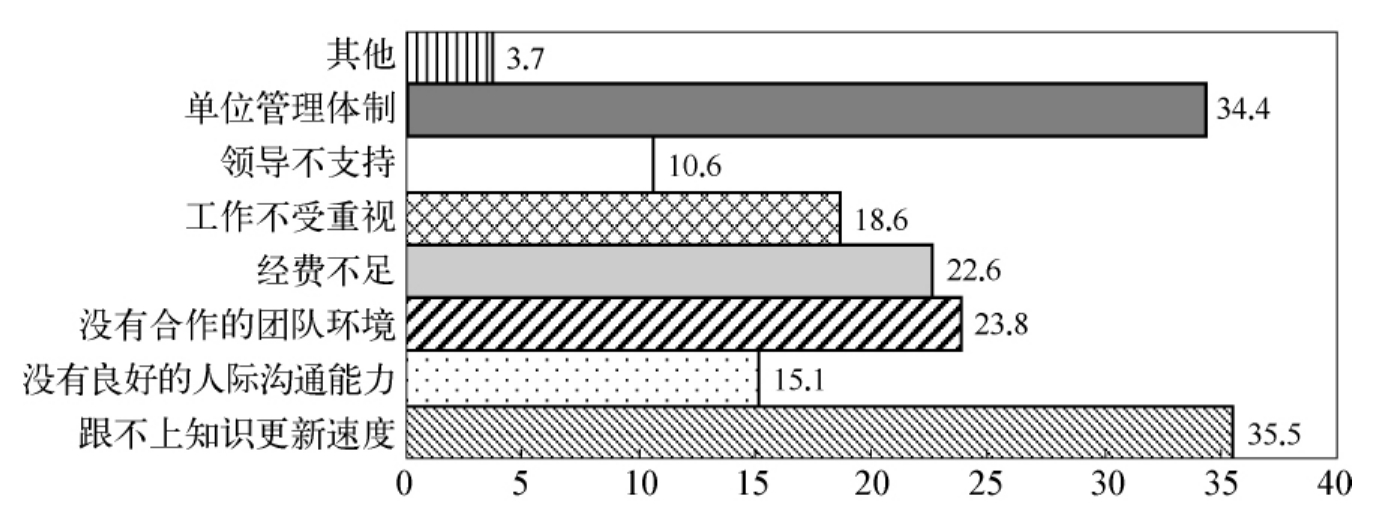第四节 上海KIBS知识员工压力状况
一、工作压力
如图5-3所示,上海KIBS知识员工的工作压力主要来自工作责任过大、职位晋升前景不明和工作时间过长。这三大压力源是今后组织人才工作需要重点改善之处。一方面,较少单位通过工作分析、岗位胜任资格分析和人岗匹配分析,赋予KIBS知识员工适度的工作责任,避免出现过大的工作压力和过长的工作时间并降低工作失职的风险;另一方面,更少单位建立清晰的多维职业发展通道,使KIBS知识员工明确职业发展定位和努力方向。
图5-3 上海KIBS知识员工工作压力源(单位:%)
事实上,在全球劳动力市场环境下的职业发展,不仅要依靠个人素质(如知识、经验、技能),还要看很多其他的因素,如语言表达能力、工资水平、职业证书、人力资源管理等(Bin &Morris,2006)[26]。以针对IT新人的一项研究为例,在中国,由于潜在文化的影响,北京和上海的IT新人的认识就有许多不同之处,上海IT新人的认识更接近于美国的IT新人的观点。北京IT新人认为雇主有责任提供职业发展的机会,同时雇员有义务不断提高自己的技能水平(King &Bu,2005)[27]。
一些经理相信员工应全心全意地投入工作才能成功(Perlow,1995)[28]。工作时间和家庭时间很难有清楚的界线,两种时间通常都相互交叉:如将家庭时间用于工作等。建立工作机动性和预防工作压力是防止冲突的两个很有效的途径。解决这一问题的巧妙方法之一是弹性工作时间制(Poelmans &Sahibzada,2004)[29]。弹性工作时间制的研究表明,采用这一策略的企业的上班缺勤情况和对工作的满意情况明显有所好转(Narayanan &Nath,1982[30];Pierce &Newstrom,1983[31])。弹性工作时间制有助于提高生产率和员工士气,减少人员流动、缺勤和加班(Dalton &Mesch,1990[32];Guy,1993[33];Mellor,1986[34];Rubin,1979[35];Swart,1985[36])。还有些研究人员发现还能减小压力(Staines &Pleck,1984[37]),提高工作热情(Grover &Crooker,1995[38])和对工作的满意度(Golembiewski,Hilles &Kagno,1974[39];Orpen,1981[40]),对生产率或工作表现没有负面影响(Schein,Maurer&Novak,1977[41])。Marshall and Barnett(1994)发现弹性工作时间制有助于减少工作-家庭矛盾,提高工作积极性和满意度[42]。
进一步地,工作压力是导致工作-家庭矛盾的主要原因,不但在美国如此(Frone,2003[43]),在其他国家也是(Poelmans,Chinchilla &Cardona,2003[44])。另一系列关于工作-家庭矛盾所产生的结果的研究有有力的证据表明工作-家庭矛盾对生活舒适有负面影响,如对工作和生活的失望(Kossek &Ozeki,1998[45])和压力(Allen,Herst,Bruck &Sutton,2000[46])。
二、工作困难
图5-4显示,上海KIBS知识员工在工作中面临的最大困难是:跟不上知识更新速度、单位管理体制、没有合作的团队环境、经费不足。这四方面需要政府和组织的重点关注。尤其是在知识经济时代,综合前文对KIBS知识员工培训的分析,目前对于KIBS知识员工而言,增加培训投入、增强培训效果是当前人力资源管理与开发的重中之重。

图5-4 上海KIBS知识员工工作困难(单位:%)
三、生活困难
图5-5显示,目前上海KIBS知识员工生活中最大的一项困难是收入低,第三是住房问题,二者比较一致,即经济因素是生活困难的首要问题。其次是工作忙,结合工作压力源分析,加强工作时间管理,显得格外重要。
图5-5 上海KIBS知识员工生活困难(单位:%)
四、身体状况
图5-6显示,上海KIBS知识员工总体身体健康,患病率比较低,仅占6.3%。但是亚健康比例也较高,不可忽视。就压力对人体健康的影响来说,一般认为消化道疾病(如胃溃疡)、糖尿病和脑血管疾病(如高血压)的发生与压力密切相关。结合实地调研,被访者普遍表示尚未受到这些疾病的危害,但脂肪肝、消化道疾病、睡眠障碍等不同程度存在。这说明工作、生活等方面压力尚未对上海KIBS知识员工的身体健康产生明显的负面影响,但是已经存在消极影响的趋势,值得引起各界注意。当然,这可能与上海KIBS知识员工中青年人比重大有关。
图5-6 上海KIBS知识员工的身体状况(单位:%)
五、生理健康管理
图5-7显示,近一半上海KIBS知识员工所在单位一年组织员工体检一次,仅有13%的单位从未组织过员工体检。反映出绝大部分单位比较重视员工生理健康的管理。
5-7被调查者所在单位员工体检的频率(单位:%)
六、心理健康影响因素
图5-8显示,影响上海KIBS知识员工心理健康的最主要因素是:工作压力和发展空间。总体上,当前工作的责任大、时间长是造成工作压力的外在原因,职业发展是工作压力的内在原因。
图5-8 影响上海KIBS知识员工心理健康的主要因素(单位:%)
【注释】
[1]Warner,M.(1993)“Human Resource Management‘with Chinese Characteristics’”,International Journal of Human Resource Management,4:45-65.
[2]Bj9rkman,I.and Lu,Y.Human Resource Management Practices in Foreign Invested Enterprises in China:What Has Been Learned?In Stewart,S.and Carver,A.(eds.)Advances in Chinese Industrial Studies,Vol.5.Greenwich,CT:JAI Press,1997:155-172.
[3]Lu,Y.and Bj9rkman,I.HRM Practices in China-Western Joint Ventures:MNC Standardization versus Localization,International Journal of Human Resource Management,1997,8(5):614-628.Lu,Y.and Bj9rkman,I.Human Resource Management in International Joint Ventures in China,Journal of General Management,1998,23(4):63-79.
[4]Ying Chu Ng,Noel Y.M.Siu,Norihiko.Training and enterprise performance in transition:evidence from China.International Journal of Human Resource Management,Jun/Aug 2004,15(4/5):878-894.
[5]Ding,D.Z.and Akhtar,S.The Organizational Choice of Human Resource Management Practices:A Study of Chinese Enterprises in Three Cities in the PRC,The International Journal of Human Resource Management,2001,12(6):946-964.
[6]Ding,D.Z.and Akhtar,S.The Organizational Choice of Human Resource Management Practices:A Study of Chinese Enterprises in Three Cities in the PRC,The International Journal of Human Resource Management,2001,12(6):946-964.
[7]Ying Chu Ng,Noel Y.M.Siu,Norihiko.Training and enterprise performance in transition:evidence from China.International Journal of Human Resource Management,Jun/Aug 2004,15(4/5):878-894.
[8]Warner,M.Human Resource Management with Chinese Characteristics,International Journal of Human Resource Management,1993,4(1):45-65.
Warner,M.Managing China’s Enterprise Reforms:A New Agenda for the 1990s’,Journal of General Management,1996,21(3):1-18.
[9]Child,J.Management in China during the Age of Reform.Cambridge:Cambridge University Press,1994.
[10]Lu,Y.and Bj9rkman,I.HRM Practices in China-Western Joint Ventures:MNC Standardization versus Localization,International Journal of Human Resource Management,1997,8(5):614-628.
[11]Zhu,C.J.Human Resource Development in China during the Transition to a New Economic System,Asia Pacific Journal of Human Resources,1997,35(3):19-44.
[12]Anderson Jr,Edward G.Managing the impact of high market growth and learning on knowledge worker productivity and service quality European Journal of Operational Research,2001,134(3):508-524.
[13]Cable,J.and FitzRoy,F.(1980)Production Efficiency,Incentives and Employee Participation:Some Preliminary Results for West Germany,Kylos,33:100-121.
[14]Buchko,A.A.(1993)The Effects of Employee Ownership on Employee Attitudes:An Integrated Causal Model and Path Analysis,Journal of Management Studies,30:633-657.
[15]Greengard,S.(1999)Stock Options Have Their Ups and Downs,Workforce,12:44-47.
[16]Holland,T.(2000)A Piece of the Pie,Far Eastern Economic Review,3:40-42.
[17]Islanabad.(1999)Stock Options,the New Fad in Town,Businessline,9:1.
[18]Klein,K.(1987)Employee Stock Ownership and Employee Attitudes:A Test of Three Models,Journal of Applied Psychology,72:319-332.
[19]Chambers,N.(1997)Ownership Gets Big,Management Review,86(7):15-19.
[20]French,J.L.(1987)Employee Perspectives on Stock Ownership:Financial Investment or Mechanism of Control?,Academy of Management Review,12:427-435.
[21]Pierce,J.L.,Rubenfeld,S.A.and Morgan,S.(1991)Employee Ownership:A Conceptual Model of Process and Effects,Academy of Management Review,16:121-144.
[22]Buchko,A.A.(1992)Employee Ownership,Attitudes and Turnover:An Empirical Assessment,Human Relations,45(7):711.
[23]French,J.L.(1987)Employee Perspectives on Stock Ownership:Financial Investment or Mechanism of Control?,Academy of Management Review,12:427-435.
[24]Klein,K.(1987)Employee Stock Ownership and Employee Attitudes:A Test of Three Models,Journal of Applied Psychology,72:319-332.
[25]Mathieu,J.E.and Zajac,D.M.(1990)A Review and Meta-analysis of the Antecedents,Correlates and Consequences of Organizational Commitment,Psychological Bulletin,108:171-194.
[26]Bin Wu;Morris,Jonathan.A life on the ocean wave:the“post-socialist”careers of Chinese,Russian and Eastern European seafarers.By:International Journal of Human Resource Management,Jan 2006,17(1):25-48.
[27]King,Ruth C.;Bu,Nailin.Perceptions of the mutual obligations between employees and employers:a comparative study of new generation IT professionals in China and the United States.International Journal of Human Resource Management,Jan 2005,Vol.16Issue 1,p.46-64.
[28]Perlow,L.(1995)Putting the work back into work/family.Group and Organization Management,20,227-239.
[29]Poelmans,Steven;Sahibzada,Khatera.A multi-level model for studying the context and impact of work family policies and culture in organizations.Human Resource Management Review Volume:14,Issue:4,December 2004,pp.409-431.
[30]Narayanan,V.K.&Nath,R.(1982)A field test of some attitudinal and behavioral consequences of flextime.Journal of Applied Psychology,67,214-218.
[31]Pierce,J.L.&Newstrom,J.W.(1983)The design of flexible work schedules and employee responses:Relations and process.Journal of Occupational Behaviour,4,247-262.
[32]Dalton,D.R.&Mesch,D.(1990)The impact of flexible scheduling on employee attendance and turnover.Administrative Science Quarterly,35,370-387.
[33]Guy,M.E.(1993)Workplace productivity and gender issues.Public Administration Review,53(3),282-297.
[34]Mellor,E.F.(1986)Shift work and flextime:How prevalent are they?Monthly Labor Review,109,14-21.
[35]Rubin,R.S.(1979)Flextime:Its implementation in the public sector.Public Administration Review,39,277-282.
[36]Swart,J.C.(1985)Clerical workers on flextime:A survey of three industries.Personnel,62,40-44.
[37]Staines,G.L.&Pleck,J.H.(1984)Nonstandard work schedules and family life.Journal of Applied Psychology,69(3),515-523.
[38]Grover,S.L.&Crooker,K.J.(1995)Who appreciates family-responsive human resource policies:The impact of familyfriendly policies on the organizational attachment of parents and non-parents.Personnel Psychology,48,271-287.
[39]Golembiewski,P.T.,Hilles,R.&Kagno,M.S.(1974)A longitudinal study of flexitime effect:Some consequences of an OD structural intervention.Journal of Applied Behavioral Science,4,503-532.
[40]Orpen,C.(1981)Effect of flexible working hours on employee satisfaction and performance:A field experiment.Journal of Applied Psychology,66(1),113-115.
[41]Schein,V.E.,Maurer,E.H.&Novak,J.F.(1977).Impact of flexible working hours on productivity.Journal of Applied Psychology,62,463-465.
[42]Marshall,N.L.&Barnett,R.C.(1994)Family-friendly workplaces,workfamily interface,and worker health.In G.P.Keita &I.J.Hurvell(Eds.),Job stress in a changing workforce:Investigating gender,diversity,and family issues(pp.253-264).Washington,DC 7American Psychological Association.
[43]Frone,M.R.(2003)Work-family balance.In J.C.Quick &L.E.Tetrick(Eds.),Handbook of occupational health psychology(pp.143-162).Washington,DC 7American Psychological Association.
[44]Poelmans,S.,Chinchilla,N.&Cardona,P.(2003)Family-friendly HRM policies and the employment relationship.International Journal of Manpower,24(3),128-147.
[45]Kossek,E.E.&Ozeki,C.(1998)Work-family conflict,policies,and the job-life satisfaction relationship:A review and directions for organizational behavior-human resources research.Journal of Applied Psychology,83(2),139-149.
[46]Allen,T.D.,Herst,D.E.L.,Bruck,C.S.&Sutton,M.(2000)Consequences associated with work-to-family conflict:A review and agenda for future research.Journal of Occupational Health Psychology,5,278-308.
免责声明:以上内容源自网络,版权归原作者所有,如有侵犯您的原创版权请告知,我们将尽快删除相关内容。
















